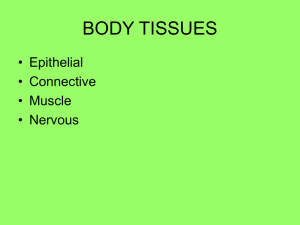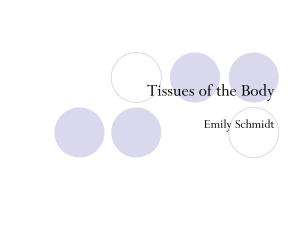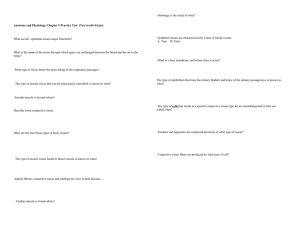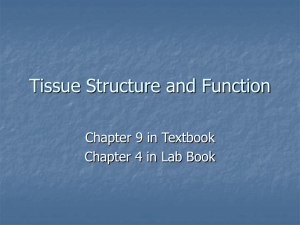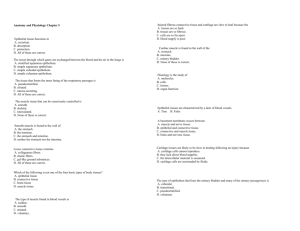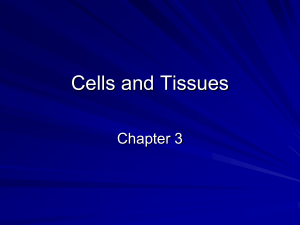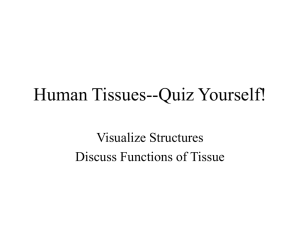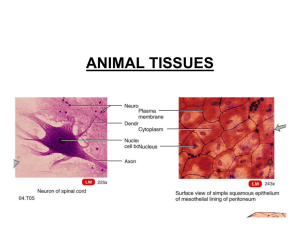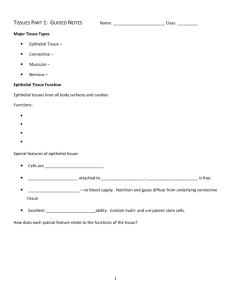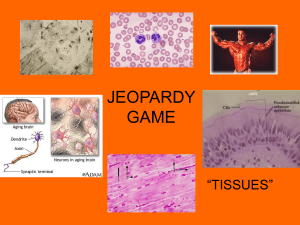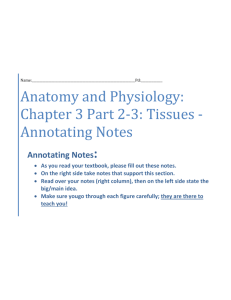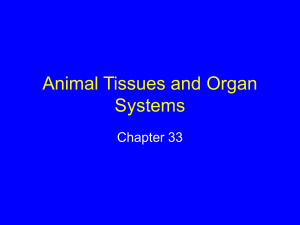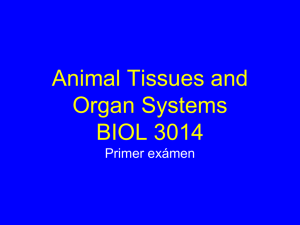Homework 4
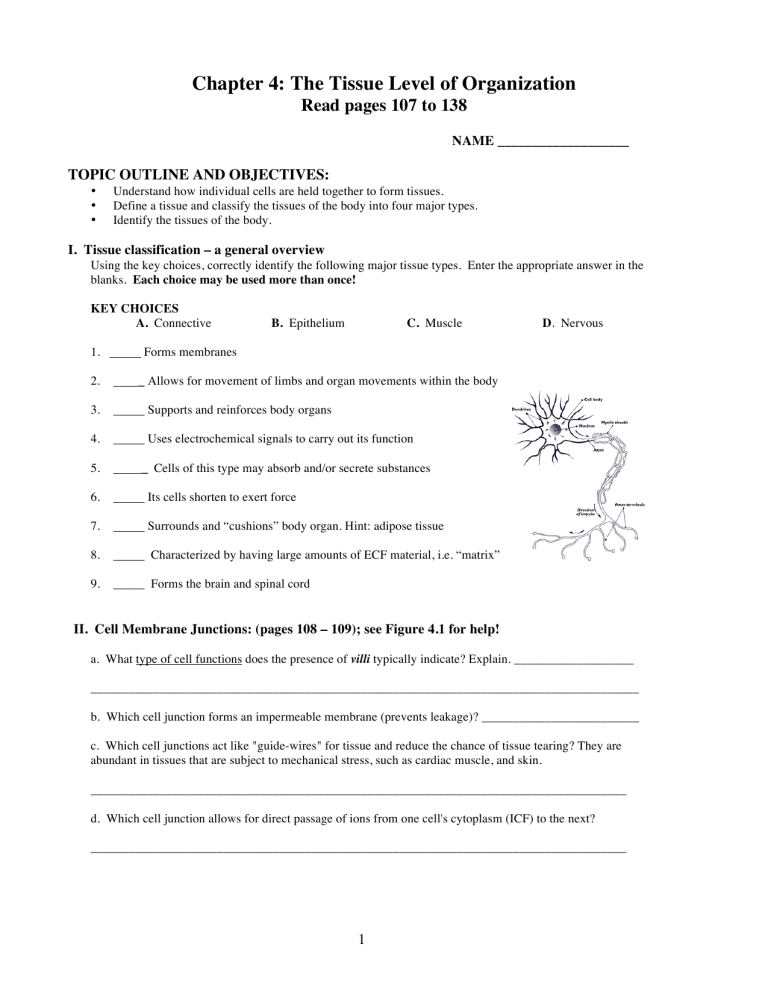
Chapter 4: The Tissue Level of Organization
Read pages 107 to 138
NAME ___________________
TOPIC OUTLINE AND OBJECTIVES:
• Understand how individual cells are held together to form tissues.
• Define a tissue and classify the tissues of the body into four major types.
• Identify the tissues of the body.
I. Tissue classification – a general overview
Using the key choices, correctly identify the following major tissue types. Enter the appropriate answer in the blanks. Each choice may be used more than once!
KEY CHOICES
A.
Connective B.
Epithelium C.
Muscle D . Nervous
1. Forms membranes
2.
_ Allows for movement of limbs and organ movements within the body
3.
Supports and reinforces body organs
4.
Uses electrochemical signals to carry out its function
5.
_ Cells of this type may absorb and/or secrete substances
6.
Its cells shorten to exert force
7.
Surrounds and “cushions” body organ. Hint: adipose tissue
8.
Characterized by having large amounts of ECF material, i.e. “matrix”
9.
_____ Forms the brain and spinal cord
II. Cell Membrane Junctions: (pages 108 – 109); see Figure 4.1 for help!
a. What type of cell functions does the presence of villi typically indicate? Explain. ___________________
_______________________________________________________________________________________ b. Which cell junction forms an impermeable membrane (prevents leakage)? _________________________ c. Which cell junctions act like "guide-wires" for tissue and reduce the chance of tissue tearing? They are abundant in tissues that are subject to mechanical stress, such as cardiac muscle, and skin.
_____________________________________________________________________________________ d. Which cell junction allows for direct passage of ions from one cell's cytoplasm (ICF) to the next?
_____________________________________________________________________________________
1
III. Epithelium (pages 110 – 121)
1.
List and describe (with examples) the six major functions of epithelium.
a.
_________________________________________________________________________________ b.
_________________________________________________________________________________ c.
_________________________________________________________________________________ d.
_________________________________________________________________________________ e.
_________________________________________________________________________________ f.
_________________________________________________________________________________
2.
List six special characteristics of epithelium. a.
__________________________________________________________________________________ b.
__________________________________________________________________________________ c.
__________________________________________________________________________________ d.
__________________________________________________________________________________ e.
__________________________________________________________________________________ f.
__________________________________________________________________________________
3.
List the two criteria used for naming epithelial tissues:
a.
_________________________________
b.
_________________________ give an e.g
. ___________________________________________________________
IV. Connective Tissue (pages 121 – 134)
1.
List five special characteristics of connective tissue. a. __________________________________________________________________________________ b. __________________________________________________________________________________ c. __________________________________________________________________________________ d. __________________________________________________________________________________ e. __________________________________________________________________________________
2.
Using the key choices , correctly identify the following major tissue types. Enter the appropriate answer in the blanks next to the statements on the next page ( → ). Some may be used more than once or not at all!
KEY CHOICES:
A.
Adipose connective tissue
B.
Dense connective tissue
C. Elastic cartilage
D.
Fibrocartilage
E. Osseous (bone) tissue
F.
G.
Areolar “loose” connective tissue
Vascular tissue (blood)
I. Hyaline cartilage
H. Elastic connective tissue
2
1. Parallel bundles of collagen fibers provide strength; found in tendons & ligaments.
2. _ Stores fat (triglycerides).
3. The skin dermis.
4. Hardest tissue of our “skull cap”.
5. Firm, slightly “rubbery” matrix; milky white and “glassy” in appearance. Found on the ends of long bones, for example, on the end of a drumstick.
6. _ Cells are arranged in concentric circles around a nutrient canal; matrix is hard due to calcium and phosphate salts.
7. Good insulator of body heat.
8. Found in external ear.
9. ______ Covers the surface of bones at joints. Forms the embryonic skeleton.
10. ______ Provides the medium for nutrient transport throughout the body.
11. ______ Acts as a shock absorber between the vertebrae, i.e. intervertebral discs.
12. ______ Makes up the basement membrane (the anchor for the epithelial tissue).
13. ______ One type of cell that typically moves around within extracellular fluid.
14. ______ Found in vocal cords and in bronchial tubes of lungs.
V. Muscle Tissue (pages 134 – 136) b. c. d.
For the three types of muscle tissue below give their a) location , b) appearance , c) number of nuclei , and if their contraction is d) voluntary or involuntary .
a.
Skeletal Muscle Smooth Muscle Cardiac Muscle
VI. Nervous Tissue (pages 136 – 137)
In the space provided draw and label a typical neuron. Be sure to label the following structures and use an arrow ( → ) to show the direction of a nerve impulse:
Axon Dendrites Nucleus Cell body Axon terminal a.
Describe briefly how the particular structure of a neuron relates to its function in the body.
3
VII.
(blood vessel)



